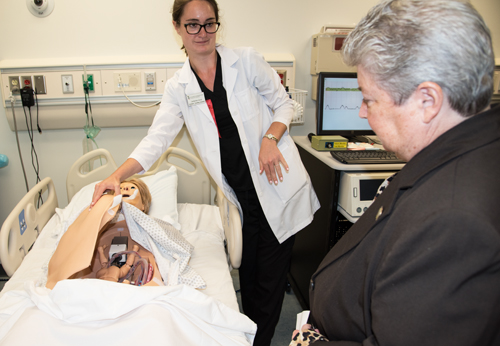Nursing Simulation Lab in Shady Grove Upgraded
A major upgrade to the clinical simulation labs at the University of Maryland School of Nursing (UMSON) at the Universities at Shady Grove (USG) will allow more students to gain critically important experience, UMSON Dean Jane M. Kirschling, PhD, RN, FAAN, told faculty and staff from the two institutions, representatives from local health care agencies, and elected leaders at a Sept. 18 gathering at USG. “Clinical simulation allows students to gain experience through participating in highly realistic case scenarios under faculty supervision,” she said. Such experience “builds competency and confidence without the potential for compromising patients’ safety.”
Kirschling added that simulation labs also allow students to experience rare and critical events that they may never see during their nursing education but may very well experience in their careers as nurse clinicians. “These experiences prepare students for work in hospitals and outpatient settings, as well as for home visits,” she said.

A demonstration shows birthing manikin "Noelle" with a baby manikin inside the simulated womb.
UMSON has added two new clinical simulation labs at USG, bringing the total number at the Rockville location to eight, and modernized and refurbished six of the existing labs, including an obstetrics and pediatrics lab. In addition, $128,000 provided by William “Bill” and Joanne Conway’s Bedford Falls Foundation has been used to purchase new equipment ranging from beds, manikins, and intravenous pumps to new cameras and an upgrade in software used for recording validations and standardized patient encounters.
Additional support was provided by the Maryland Nurse Support Program II (NSP II). NSP II grants, which are funded by the Maryland Health Services Cost Review Commission and administered by the Maryland Higher Education Commission, have been instrumental in fostering the expansion and education of the state’s nursing workforce.
In its landmark 2010 study, The Future of Nursing: Leading Change, Advancing Health, The Institute of Medicine found that addressing the increasing complexity of health care and the growing diversity of our communities requires greater numbers of highly educated nurse clinicians, nurse educators, and nurse scientists.
UMB President Jay A. Perman, MD, who chairs a University System of Maryland study group examining the needs of Maryland’s health care workforce, said increased access to advanced simulation labs is key to solving that need. “Among the very first issues the group chose to tackle was the availability of simulation facilities,” he told the gathering. “Because everyone agrees that making sure students get adequate experience in simulated environments is absolutely central to preparing a skilled workforce.”
Perman also explained that UMB is committed to strengthening the health care workforce throughout the state, “making sure that all across Maryland in every region we have a well-qualified health care workforce, that there’s nowhere in Maryland where Marylanders will struggle to find a provider, where one will struggle to find ready, capable care. And that’s why it’s so important that UMB’s School of Nursing be represented here in a highly strategic place like Montgomery County, with its dense population and its considerable health care needs,” he said.
Also benefiting from the upgrades is the facility’s Objective Structured Clinical Examination (OSCE) suite, clinical space shared by UMSON and the University of Maryland School of Pharmacy. The suite features multiple clinical spaces, including an apartment setting and many exam rooms. All have cameras and microphones so instructors can observe student interactions with patients and provide immediate feedback.
Perman noted that OSCE suites help teach team-based, or interprofessional, care - especially critical in managing chronic conditions like diabetes, asthma, and high blood pressure – by allowing nursing students to interact with pharmacy students.
After a ceremonial ribbon cutting, visitors took guided tours of all three floors of simulation labs in USG’s Building I. In the obstetrics area, a faculty member introduced them to Noelle, a manikin capable of simulating childbirth and even complications such as breech birth, when a baby is born feet first. Noelle can “speak” with students, providing important feedback.
Nearby, in the pediatrics area, an infant manikin can present students with other challenging critical situations, such as sudden cyanosis (skin turning blue) due to hypoxia, or an insufficient supply of oxygen.
UMSON established a Bachelor of Science in Nursing (BSN) program at USG at its opening in 2000. Since that time, the School’s educational offerings have expanded greatly, including a Registered Nurse-to-BSN degree, and as of this fall, the Doctor of Nursing Practice program’s Family Nurse Practitioner specialty.
The Family Nurse Practitioner specialty prepares advanced practice nurses to be primary health care providers for individuals of all ages and their families. Students develop expertise in the management of care for individuals across the lifespan, emphasizing health promotion and disease prevention as well as diagnosis and management of acute and chronic diseases.
Overall, 21 UMSON faculty and staff members work at USG, supporting 310 nursing students. This fall, 39 percent of entry-level baccalaureate students enrolled at UMSON are obtaining their degrees at USG, helping to achieve UMSON’s goal of making it more convenient and attractive for students and practicing nurses from the western regions of Maryland to obtain nursing education and degrees.
“I remember talking to Dean Kirschling several years ago about the School of Nursing at USG and saying, you know, it’s a great program,” remembered USG Executive Director Stewart Edelstein, PhD. “We’d love to be able to have more of you, and I mentioned specifically the Doctor of Nursing Practice. I remember her being very cautious over lunch saying, ‘Well, let me look into that; let me see if that’s possible.’ Here it is, several years later and the program is here and it’s due in large measure to her leadership.”



